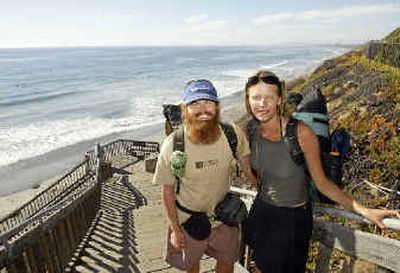Coastal trek nearly complete

SAN DIEGO – Forget a Global Positioning System or even a map. The Earth’s own original satellite is the most important guide for two hikers making the first known continuous trek of the nation’s western coastline.
“The moon,” hiker Nate Olive said. “It really decides our path.”
Lunar phases have shaped much of the pair’s 1,800-mile journey, determining tidal fluctuations that can spell the difference between a walk on the beach or wading.
As the end of their expedition nears, the two ecologists wonder how it will feel to return to lives that don’t involve continuous hiking.
For 3 1/2 months, they have been on the move constantly, walking nearly 20 miles a day, threading their way across beaches, rain forests and farm country. On Tuesday, they expect to reach the end of the West Coast Trail – the fence marking the U.S.-Mexico border.
“We’re so used to waking up every day and walking,” Olive said Saturday during a respite in San Diego. “We’ve thought about that day when we reach Mexico and they’ll be no more miles to walk.”
“It’s going to be hard. But at the same time, we’re excited.”
Olive, 28, and his companion, Sarah Janes, 23, set out in June from the northwest tip of Washington. Both are taking a break from jobs with the National Park Service.
They keep their backpacks as light as possible, carrying a two-person sleeping bag, a tarp, a stove made of aluminum cans, basic clothing and food. They are lean and tanned, and Olive’s curly red beard is long.
Along the way, they have contended with poison oak, fierce sunshine, detours around private property and constantly sore feet, but they persevered through the discomfort.
“Even if you are tired, there’s so much excitement about what’s coming up,” Olive said.
Once they cross the border, the pair will become the first hikers to complete the journey in a single trip.
Al LePage, executive director for the National Coast Trail Association, has walked the trail in three separate legs, but knows of no one else who finished in one continuous hike.
It’s unlikely that American Indians or early explorers did so because the route was not practical for food collection and other reasons, LePage said. A solo hiker attempting the feat is about two months behind Olive and Janes.
Olive and Janes are seasoned long-distance hikers, having completed a 2,650-mile trek of the Pacific Crest Trail along the spine of the Cascades and the Sierra Nevada. Olive also hiked the Appalachian Trail, stretching 2,170 miles from Maine to Georgia.
The two hope to promote and mark the West Coast Trail, parts of which are not yet linked, for the trail association.
They are also documenting the trip online, and Olive is writing a book titled “Dancing the Tidal Line.”
Their journey down the Pacific coast has taken them through wilderness and rain forest, past “fairy tale” scenes of trees sprouting from rock towers in the sea, to urban Southern California, where the two were sometimes mistaken for homeless wanderers.
A trip through the military’s Camp Pendleton last week paired Olive and Janes with two Marines recently returned from the war in Iraq. An inland detour around Vandenberg Air Force Base led them past farmworkers toiling under the hot sun.
Since passing Santa Barbara, they have increasingly had to clamber over sea walls and jetties, many erected by homeowners trying to curb erosion. In much of California, they have also had to avoid sewage-contaminated rivers.
“We’ve developed such a strong relationship with nature, plants, animals and our surroundings,” Olive said. “I can hear the land crying out at times, but I don’t want to focus on that. I do believe things can change.”